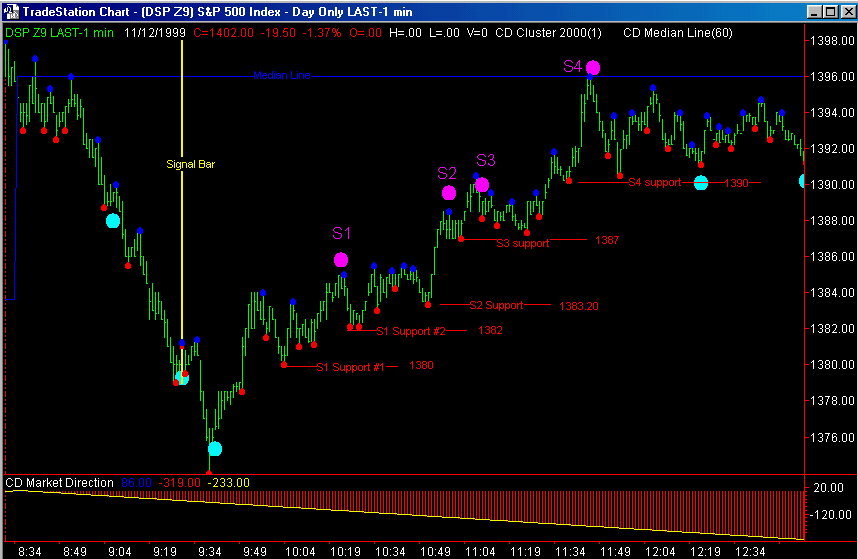Full SPECTRUM Trader
Support Resource Center
Chart 37.1
CD Entry Point Indicator

Chart 37.1
CD Entry Point Indicator

This is a chart from the S&P contract displaying a classic example of why the CD Entry Point Indicator is a vital tool not only to tell you where to enter the market but also as a tool to keep you from trading in the wrong direction.
Note on this day that the Market Direction Indicator is signifying a down day, as evidenced by the declining red pattern on our histogram below the chart.
Recal that on such days we will emphasize trading from the short side since the major trend is down.
Note that there are frequent sell signs painted on the chart by our various indicators as the market corrects from the steep plunge early in the day. If we had acted solely on the sell signals we received on this corrective move we would have undoubtedly experienced multiple consecutive losses.
However, by using the Entry Point Indicator, we were able to so define out entres in such a manner that the market failed to activate our entry point by violating support below the market.
In the chart above you can see where I actually placed sell stops throughout the day. Each short, horizontal red line marks the point and time at which I moved the sell stop up behind the market. Note how, with the formation of each new sell window, I moved the sell stop. The expectation was, of course, that the correction would run out of steam and the market would resume it's downtrend. However, when that did not happen, I was not caught short in a rising market.
At point S1, the first sell signal issued by the CD Cluster Indicator, support was indicated at the 1380 level as indicated above.
As the market rallies, support is moved to a higher level at 1382. It is quite important to note here that it pays big dividends to wait until the market has moved a distance from the new support level before moving your sell stop to that level. Placing the sell stop too close to the active market can result in accidental entry and a position that may not work in the manner you had intended. Note the pattern of stop movement above for an example of conservative stop placement and how it was able to keep me out of trouble all morning.
The sell stop was moved to 1383.20 when the S2 sell signal was printed, as this was the location of the nearest logical support level at this time.
When the S2 sell signal was given, the stop was moved to support at 1387 as indicated above.
Finally, the sell stop was moved to 1390 when the S4 signal was printed on the screen.
In fact, this pattern continued into the afternoon, resulting in no trades for this day.
Although this is somewhat of a rare day, it is an excellent example of the absolute necessity of using the CD Entry Point Indicator as a confirmatory tool when entering the market.
This is an excellent illustration of how the CD Entry Point Indicator can keep you out of trouble when the Market Direction and Median Line Indicators, historically proven to be 80% accurate, have an off day and give an incorrect assessment of the direction of the trade for the rest of the day. We all know that any trading method is never 100% accurate. Using this method can certainly lessen the impact of the incorrect signals when used as desctibed above.
To review, the Entry Point Indicator works by defining short term support and resistance in the market. When we get signals of upside exhaustion, we place our sell stop at the point indicated by the Entry Point Indicator. The market must then confirm the change in trend by trading lower and breaking the short term suport as defined by the red dots below the barss on the chart above.
Return to Chart 37 - CD Entry Point Indicator
General Information